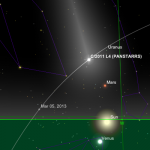Like so many other amateur astronomers, I am eagerly awaiting the appearance of Comet C/2011 L4 Pan-STARRS.
The comet was discovered in June of 2011, by the Pan-STARRS survey telescope atop Haleakala, Maui. The comet will pass closest to earth on March 5th, at a distance of 1.09 au. Perihelion, the comet’s closest approach to the Sun, occurs early on March 10th UT.

Initial predictions were quite optimistic with this comet, indicating a possible -1 magnitude for the comet. Reality seems to be somewhat more restrained, with a peak somewhere between magnitude one and two being more likely. Reports indicate that the comet has brightened to about 2nd magnitude, bright enough to be easily seen without optical aid.
Even more convenient, the comet will be well placed for observation this coming weekend. With new moon occurring on March 11th, this will be the prime weekend for a telescope outing. Amateur astronomers everywhere are already planing for this weekend. Our local club is no exception, expect a good crowd of telescopes to be at the Mauna Kea VIS this weekend. Myself? I will probably setup at the Substation site, just across the road from the VIS. The site offers a much better western horizon, which is blocked from the VIS by a line of pu’u, old cinder cones.
I will be taking photo gear, looking to get a decent photo of the comet. Stay tuned to Darker View to see the results if I meet with any success.
The latest orbital elements from the MPC
Another interesting opportunity will come on March 12th, when a slim crescent Moon will join the comet in the sky. A 1.4 day old moon, about 2% illuminated will be about 4° north (to the right) of the comet.

